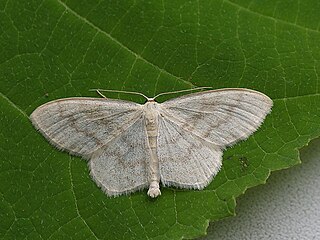
The cream wave is a moth of the family Geometridae. The species was first described by Adrian Hardy Haworth in 1809. It is found in forest and woodland regions, feeding on grasses and small plants such as dandelion.

Sterrhinae is a large subfamily of geometer moths with some 3,000 described species, with more than half belonging to the taxonomically difficult, very diverse genera, Idaea and Scopula. This subfamily was described by Edward Meyrick in 1892. They are the most diverse in the tropics with the number of species decreasing with increasing latitude and elevation.

Zythos turbata is a moth of the family Geometridae first described by Francis Walker in 1862. It is found in southern Myanmar and on Borneo, Sumatra, Java, Peninsular Malaysia and the Philippines.
Scopula anisopleura is a moth of the family Geometridae. It was described by Hiroshi Inoue in 1982. It is endemic to Japan.
Scopula apicipunctata is a moth of the family Geometridae. It was described by Hugo Theodor Christoph in 1881. It is found in Siberia, the Kuriles and Japan.
Scopula pudicaria is a moth of the family Geometridae. It is found from north-eastern China to south-eastern Russia, Korea and Japan.
Scopula indicataria is a moth of the family Geometridae. It is found in China, Korea, Japan and Russia.

Scopula butleri is a moth of the family Geometridae. It was described by Prout in 1913. It is found in the north-eastern Himalaya, Sumatra, China, Japan and Borneo. The habitat consists of lowland forests and lower montane forests.

Scopula caesaria is a moth of the family Geometridae. It has a wide range, including the Comoros, Mayotte, La Réunion, Madagascar and in Mauritius, Nigeria, South Africa, Tanzania, Gambia, Oman, the United Arab Emirates, New Guinea, Taiwan, Japan and Australia (Queensland).
Scopula confusa is a moth of the family Geometridae. It was described by Arthur Gardiner Butler in 1878. It is found in southern Japan and the Russian Far East.

Scopula corrivalaria is a moth of the family Geometridae. It is found from Japan, Korea, China and the Russian Far East through Siberia and Russia to western Europe. In Europe, it ranges from northern Central Europe to the Mediterranean. The habitat consists of marshes and wet meadows.
Scopula ichinosawana is a moth of the family Geometridae. It is found in Japan and Russia.
Scopula ignobilis is a moth of the family Geometridae. It is found in Japan, Russia, Korea, Taiwan and China.
Scopula impersonata is a moth of the family Geometridae. It is found in China, the Russian Far East, Taiwan and Japan.
Scopula limbata is a moth of the family Geometridae. It was described by Wileman in 1915. It is found in Taiwan and Japan.

Scopula luridata is a moth of the family Geometridae. It is found in southern Europe, Asia Minor, China, Pakistan, India, Egypt, Somalia, Yemen, Oman and Japan.
Scopula modicaria is a moth of the family Geometridae. It was described by John Henry Leech in 1897. It is found in China, the Russian Far East, Korea and Japan.
William Warren was an English entomologist who specialised in Lepidoptera.
Scopula superior is a moth of the family Geometridae. It was described by Arthur Gardiner Butler in 1878. It is found in Japan, the Russian Far East and China.
Scopula supernivearia is a moth of the family Geometridae. It was described by Inouein 1963. It is found in Japan and on the Kuriles.





